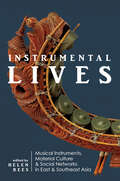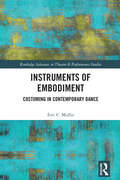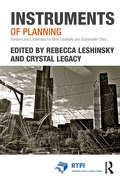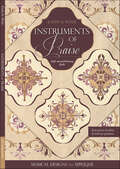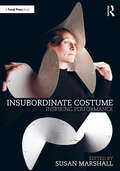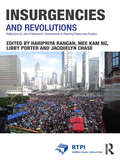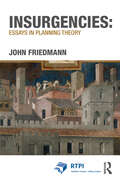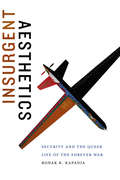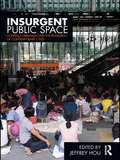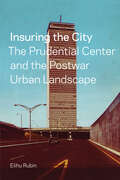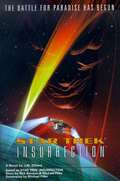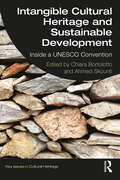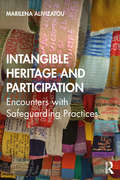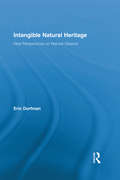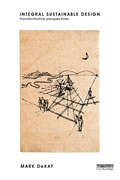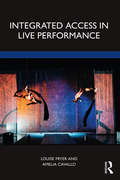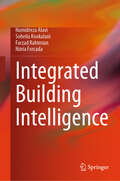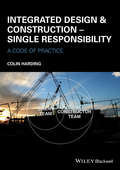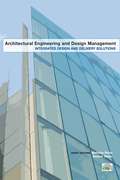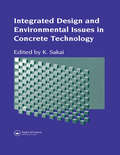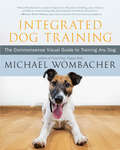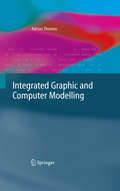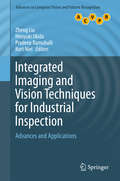- Table View
- List View
Instrumental Lives: Musical Instruments, Material Culture, and Social Networks in East and Southeast Asia
by Helen Rees Jennifer C. Post Bell Yung Terauchi Naoko Tyler Yamin Maire-Pierre Lissoir Insee AdlerThe musical instruments of East and Southeast Asia enjoy increasing recognition as parts of humanity’s intangible cultural heritage. Helen Rees edits a collection that offers vibrant new ways to link these objects to their materials of manufacture, the surrounding environment, the social networks they form and help sustain, and the wider ethnic or national imagination. Rees organizes the essays to reflect three angles of inquiry. The first section explores the characteristics and social roles of various categories of instruments, including the koto and an extinct Balinese wooden clapper. In section two, essayists focus on the life stories of individual instruments ranging from an heirloom Chinese qin to end-blown flutes in rural western Mongolia. Essays in the third section examine the ethics and other issues that surround instrument collections, but also show how collecting is a dynamic process that transforms an instrument’s habitat and social roles. Original and expert, Instrumental Lives brings a new understanding of how musical instruments interact with their environments and societies. Contributors: Supeena Insee Adler, Marie-Pierre Lissoir, Terauchi Naoko, Jennifer C. Post, Helen Rees, Xiao Mei, Tyler Yamin, and Bell Yung
Instruments of Embodiment: Costuming in Contemporary Dance (Routledge Advances in Theatre & Performance Studies)
by Eric MullisInstruments of Embodiment draws on fashion theory and the philosophy of embodiment to investigate costuming in contemporary dance. It weaves together philosophical theory and artistic practice by closely analyzing acclaimed works by contemporary choreographers, considering interviews with costume designers, and engaging in practice-as-research. Topics discussed include the historical evolution of contemporary dance costuming, Merce Cunningham’s innovative collaborations with Robert Rauschenberg, and costumes used in Ohad Naharin’s Virus (2001) and in a ground-breaking Butoh solo by Tatsumi Hijikata. The relationship between dance costuming and high fashion, wearable computing, and the role costume plays in dance reconstruction are also discussed and, along the way, an anarchist materialism is articulated which takes an egalitarian view of artistic collaboration and holds that experimental costume designs facilitate new forms of embodied experience and ways of seeing the body. This study will be of great interest to students and scholars working in performance philosophy, philosophy of embodiment, dance and performance studies, and fashion theory.
Instruments of Land Policy: Dealing with Scarcity of Land (Urban Planning and Environment)
by Thomas Hartmann Jean-David Gerber Andreas HengstermannIn dealing with scarce land, planners often need to interact with, and sometimes confront, property right-holders to address complex property rights situations. To reinforce their position in situations of rivalrous land uses, planners can strategically use and combine different policy instruments in addition to standard land use plans. Effectively steering spatial development requires a keen understanding of these instruments of land policy. This book not only presents how such instruments function, it additionally examines how public authorities strategically manage the scarcity of land, either increasing or decreasing it, to promote a more sparing use of resources. It presents 13 instruments of land policy in specific national contexts and discusses them from the perspectives of other countries. Through the use of concrete examples, the book reveals how instruments of land policy are used strategically in different policy contexts.
Instruments of Planning: Tensions and challenges for more equitable and sustainable cities (RTPI Library Series)
by Rebecca Leshinsky Crystal LegacyInstruments of Planning: Tensions and Challenges for more Equitable and Sustainable Cities critically explores planning’s instrumentality to deliver important social and environmental outcomes in neoliberal planning landscapes. Because each instrument is unique and may be tailored to its own jurisdictional needs, Instruments of Planning is a compendium of case studies from urban regions in Australia, Canada, the United States and Europe, providing readers with a collection that critically challenges the role and potential of planning instruments and instrumentality across a range of contexts. Instruments of Planning captures the political, institutional, and economic challenges that confront planning. It examines planning instruments designed to assist with strategic planning and implementation, and considers the role that technology plays in unpacking and understanding complexity in planning. Written by Rebecca Leshinsky and Crystal Legacy of RMIT University in Melbourne, Australia, this book fills the gap in planning theory about the instrumentality of planning in the neoliberal urban context. It is essential reading for students, urban researchers, policy analysts and planning practitioners.
Instruments of Praise
by Kathy K. WylieAppliqué lovers, you can make this award-winning quilt Create your own version of Kathy Wylie's heavenly “Instruments of Praise,” which won the Bernina Machine Workmanship Award at the 2011 American Quilter's Society show and is now part of the National Quilt Museum’s permanent collection. With Kathy's tips on color selection, design placement, needle turn appliqué, and embellishing, you can make this quilt even if you aren’t an appliqué expert. • Full-sized pattern and instructions for 4 blocks and corner motif inspired by Psalm 150 • Each block features a different musical instrument • Recreate the original quilt, or mix and match blocks and motifs to make your own design
Insubordinate Costume: Inspiring Performance
by Susan MarshallInsubordinate Costume: Inspiring Performance presents a comprehensive study of historical and contemporary examples of scenographic costume – the type of costume that creates an almost complete stage environment by itself, simultaneously acting as costume, set and performance.This book provides readers with an overview of the costumes, designers, context and theory that have contributed to the emerging field of ‘costume as performance’. Focusing on artists and their creative approach to space, form, materials and movement, the book looks at iconic figures such as Loïe Fuller, Oskar Schlemmer and Leigh Bowery, amongst contemporary examples of practitioners that are blurring disciplinary boundaries between fashion, dance, performance and theatre. The book includes chapters by Dr Sofia Pantouvaki, who focuses on performance costume as a means of research; Christina Lindgren, who presents the findings of the four-year Costume Agency project at Oslo National Academy of the Arts in Norway; Charlotte Østergaard, who discusses the implications of 'Listening with costume' and Felix Choong, writing on 'Contemporary Runways, Contemporary Costumes'. The final part of the volume, 'The Practitioners’ Voice', examines current practice through interviews and contributions from key practitioners with an afterword by Dr Rachel Hann.Insubordinate Costume will appeal to professional costume designers, performance artists, dancers, directors, choreographers, fashion designers and theorists, teachers and students of these subjects. With its interdisciplinary focus and unique and dynamic content, this publication is relevant to a range of art, design and performance courses.
Insurgencies and Revolutions: Reflections on John Friedmann’s Contributions to Planning Theory and Practice (RTPI Library Series)
by Libby Porter Haripriya Rangan Mee Kam Ng Jacquelyn ChaseOver the past six or more decades, John Friedmann has been an insurgent force in the field of urban and regional planning, transforming it from its traditional state-centered concern for establishing social and spatial order into a radical domain of collaborative action between state and civil society for creating ‘the good society’ in the present and future. By opening it up to theoretical engagement with a wide range of disciplines, Friedmann’s contributions have revolutionised planning as a transdisciplinary space of critical thinking, social learning, and reflective practice. Insurgencies and Revolutions brings together former students, close research associates, and colleagues of John Friedmann to reflect on his contributions to planning theory and practice. The volume is organized around five broad themes where Friedmann’s contributions have risen to challenge established paradigms and generated the space for revolutionary thinking and action in urban and regional planning – Theorising hope; Economic development and regionalism; World cities and the Good city; Social learning, empowered communities, and citizenship; and Chinese cities. The essays by the authors reflect their engagement with his ideas and the new directions in which they have taken these in their work in planning theory and practice.
Insurgencies: Essays in Planning Theory (RTPI Library Series)
by John FriedmannFor nearly fifty years John Friedmann's writings have not just led the academic study of the discipline, but have given shape and direction to the planning profession itself. Covering transactive planning, radical planning, the concept of the Good City, civil society, rethinking poverty and the diversity of planning cultures, this collection of Friedmann's most important and influential essays tells a coherent and compelling story about how the evolution of thinking about planning over several decades has helped to shape its practice. With each essay given a new introduction to establish its context and importance, this is an ideal text for the study of planning theory and history.
Insurgent Aesthetics: Security and the Queer Life of the Forever War (Art History Publication Initiative)
by Ronak K. KapadiaIn Insurgent Aesthetics Ronak K. Kapadia theorizes the world-making power of contemporary art responses to US militarism in the Greater Middle East. He traces how new forms of remote killing, torture, confinement, and surveillance have created a distinctive post-9/11 infrastructure of racialized state violence. Linking these new forms of violence to the history of American imperialism and conquest, Kapadia shows how Arab, Muslim, and South Asian diasporic multimedia artists force a reckoning with the US war on terror's violent destruction and its impacts on immigrant and refugee communities. Drawing on an eclectic range of visual, installation, and performance works, Kapadia reveals queer feminist decolonial critiques of the US security state that visualize subjugated histories of US militarism and make palpable what he terms &“the sensorial life of empire.&” In this way, these artists forge new aesthetic and social alliances that sustain critical opposition to the global war machine and create alternative ways of knowing and feeling beyond the forever war.
Insurgent Public Space: Guerrilla Urbanism and the Remaking of Contemporary Cities
by Jeffrey HouWinner of the EDRA book prize for 2012. In cities around the world, individuals and groups are reclaiming and creating urban sites, temporary spaces and informal gathering places. These ‘insurgent public spaces’ challenge conventional views of how urban areas are defined and used, and how they can transform the city environment. No longer confined to traditional public areas like neighbourhood parks and public plazas, these guerrilla spaces express the alternative social and spatial relationships in our changing cities. With nearly twenty illustrated case studies, this volume shows how instances of insurgent public space occur across the world. Examples range from community gardening in Seattle and Los Angeles, street dancing in Beijing, to the transformation of parking spaces into temporary parks in San Francisco. Drawing on the experiences and knowledge of individuals extensively engaged in the actual implementation of these spaces, Insurgent Public Space is a unique cross-disciplinary approach to the study of public space use, and how it is utilized in the contemporary, urban world. Appealing to professionals and students in both urban studies and more social courses, Hou has brought together valuable commentaries on an area of urbanism which has, up until now, been largely ignored.
Insuring the City: The Prudential Center and the Postwar Urban Landscape
by Elihu RubinAn in-depth look at Boston's Prudential Center and what its story reveals about the evolution of the modern American city The Prudential Center anchors the Boston skyline with its tall, gray tower. It is also a historical beacon, representing a midcentury moment when insurance companies such as Prudential were particularly aware of how their physical presence and civic engagement reflected upon their intangible product: financial security. Looking to New York's Rockefeller Center, the creators of the Prudential Center aspired to use real estate development as a tool toward civic achievement, reinvigorating central Boston and integrating a large complex of buildings with new infrastructure for the automobile. Now available in paperback, this award-winning book tells the full story of “The Pru,” placing it in the political, economic, and architectural contexts of the period, and providing new insights into urban renewal in postwar America.
Insurrection: Star Trek Ix Movie Novelization (Star Trek )
by J M DillardAgainst a background of an idyllic and peaceful world of eternal youth, a damaged Data goes wild, shutting down the isolation devices which conceal a Federation observation post from the native Baku. Picard is informed by the Admiral Dougherty that Data has taken the observation team and a party of Son'a delegates hostage. Now Picard enters a race against time to shut Data down and rescue the hostages. But the hostages, who are growing younger, have no desire to leave and Picard finds himself facing a terrible conflict between his principles and his orders from Starfleet.
Intangible Cultural Heritage and New Methodological Frameworks: Media, Performance and the Public Space (Routledge Research in Cultural and Media Studies)
by Eleftheria Rania Kosmidou Leslie Grace McMurtryThis book examines media, performance, and the public space as sites of intangible cultural heritage – a heritage that moves beyond physical museums and monuments to encompass film and media, performing arts, oral traditions, social practices, rituals, artifacts, and cultural spaces.Focusing on the current methodological challenges and new frameworks that surround the study of intangible cultural heritage in the public space, this volume explores the ways in which intangible cultural heritage is formed, represented, appropriated, and changed. The authors propose a broad understanding of cultural heritage emerging from the public sphere, encompassing museums, oral traditions, performing arts, social practices, artifacts, media and cultural spaces as the inclusive, collective cultural expressions of everyday culture.This unique and interdisciplinary volume will interest scholars and students of cultural studies, cultural heritage, media and film studies, performance studies, history, and sociology.
Intangible Cultural Heritage and Sustainable Development: Inside a UNESCO Convention (Key Issues in Cultural Heritage)
by Chiara Bortolotto Ahmed SkountiDrawing on debates about intangible cultural heritage (ICH) safeguarding at the local and international levels, Intangible Cultural Heritage and Sustainable Development: Inside a UNESCO Convention, explores the theoretical and practical implications of the intertwinement between these policy fields. Considering how sustainable development (SD) priorities are influencing representations of ICH, the volume questions how they are expanding the frontiers of the heritage realm and unsettling accepted understandings of the social uses of heritage. The contributing authors, who hail from a variety of different contexts and disciplinary backgrounds, explore these issues from a unique vantage point as both scholars and actors of the processes they analyze. Playing different roles in the implementation of the Convention, their positioning as insiders allows for a unique analytical perspective that is based on first-hand engagement with the practices of the Convention. Intangible Cultural Heritage and Sustainable Development: Inside a UNESCO Convention sheds light on the complexity, potential, and consequences of combining ICH and SD at the policy-making level and in heritage practices on the ground. It will be of interest to academics and students working in heritage studies, development studies, anthropology, archaeology, international law, political science, international relations, and sociology.
Intangible Heritage and Participation: Encounters with Safeguarding Practices
by Marilena AlivizatouIntangible Heritage and Participation examines participation as an intellectual and operational frame in safeguarding intangible heritage. Including case studies from the Netherlands, Belgium, Aotearoa New Zealand, Greece, Peru, Britain, Denmark, Sweden and Japan, the book provides an analysis of safeguarding as a museological framework and further investigates safeguarding practices in participatory research, memory-work and cultural transmission. Drawing on conversations about ‘the tyranny of participation’, the book looks into the complexities of participatory projects on the ground, from community research and collecting to the mapping of Indigenous values in environmental conservation and processes of active remembering of ‘difficult intangible heritage’ of forced migration, political violence and mental illness. Cautioning against the uncritical adoption of participation as a universal ethical discourse, Alivizatou argues that the ethics of cosmopolitanism should guide safeguarding practices at an international level. Intangible Heritage and Participation offers an original approach to thinking about and working with intangible heritage and, as such, should be essential reading for academics, researchers and students in, among others, the fields of cultural heritage studies, museology, anthropology and cultural development. It should also be of interest to heritage and museum professionals and anyone else interested in cultural heritage theory and practice.
Intangible Natural Heritage: New Perspectives on Natural Objects
by Eric DorfmanThe topic of intangible natural heritage is new, recently emerging as an important subject of inquiry. It describes the untouchable elements of the environment that combine to create natural objects, and help define our relationship to them. These elements can be sensory, like auditory landscapes, or processes like natural selection. As a concept, intangible natural heritage is growing in prominence, as museums are increasingly charged safeguarding and interpreting the milieux from which their objects originate. This book is a significant advance on the subject of intangible natural heritage; no book on the topic has yet been written and current scholarship is confined to a few isolated papers. As such, there exists a wide variety of perspectives on the topic. Intangible Natural Heritage presents a spectrum of opinion, making the first attempt at a unifying concept on which future work can be based. Authors from Europe, Asia, Australasia, Britain, and North America, address topics on scales from minute insects to sweeping landscapes. The common thread in these explorations is the importance of human relationships with nature that is passed down from generation to generation. In a world that is becoming increasingly fragile, recognizing and fostering these relationships has never been more vital.
Integral Sustainable Design: Transformative Perspectives
by Mark DeKayThis book offers practical and theoretical tools for more effective sustainable design solutions and for communicating sustainable design ideas to today's diverse stakeholders. It uses Integral Theory to make sense of the many competing ideas in this area and offers a powerful conceptual framework for sustainable designers through the four main perspectives of: Behaviours, Systems, Experiences and Cultures. It also uses human developmental theory to reframe sustainable design across four levels of complexity present in society: the Traditional, Modern, Postmodern, and Integral waves. Profuse with illustrations and examples, the book offers many conceptual tools including: - Twelve Principles of Integral Sustainable Design - Sixteen Prospects of Sustainable Design - Six Perceptual Shifts for Ecological Design Thinking - Five Levels of Sustainable Design Aesthetics - Ten Injunctions for Designing Connections to Nature
Integrated Access in Live Performance
by Louise Fryer Amelia CavalloTwelve per cent of UK theatregoers have a disability. This compares with 18% of the UK’s adult population. Directors can help build audiences as diverse as the population at large by making their art accessible to all. Live performances are increasingly being made accessible to people with sensory impairments not only to satisfy equality laws and the requirements of funding bodies, but also in the interest of diversity and as a catalyst for creativity. But how do you ensure you don’t throw out the access baby with the artistic bathwater? This book draws on the results of the Integrated Access Inquiry: Is It Working? A qualitative study with 20 theatremakers from around the UK, it was commissioned by Extant Theatre – the UK’s leading company of blind and visually impaired people, and combines feedback from disabled audiences with advice from the creative teams who have experimented with integrating access. It discusses the challenges and opportunities of working with disabled actors and building in audience access even before rehearsals begin. It offers strategies, case studies and a step-by-step guide to help creative people integrate access into their live performance for the benefit of all.
Integrated Building Intelligence
by Hamidreza Alavi Soheila Kookalani Farzad Rahimian Núria ForcadaThis book integrates of Building Information Modeling (BIM) and Decision Support Systems (DSS) in the field of building design, construction, and maintenance. The book explores how BIM and DSS technologies can be synergistically utilized to enhance performance, comfort, and maintenance efficiency in buildings. With an emphasis on practical applications, the book provides a comprehensive overview of the latest advancements in BIM and DSS, including real-world case studies and implementation guidelines. The book features illustrations, tables, and examples that aid in understanding complex concepts and demonstrate the practical application of BIM and DSS in building projects. Readers will gain a deep understanding of how BIM and DSS can be integrated to optimize building design, streamline construction processes, and improve facility management and maintenance. The main benefit of reading this book is that it provides a valuable resource for professionals in the architecture, engineering, and construction industries who want to leverage the power of BIM and DSS to enhance their building projects. Additionally, the book explores how BIM and DSS can contribute to energy efficiency.
Integrated Design and Construction - Single Responsibility
by Chartered Institute of Building Colin HardingManufacturing and service industries have significantly improved their levels of productivity, quality, and profitability over the past 30 years, whereas in the construction industry similar levels of improvement have been impossible to achieve. Numerous reports have identified fragmentation of the industry's management structures and processes as the underlying cause of the waste and inefficiencies that keep costs high and margins low. Integrated Design and Construction is an integrated yet competitive form of procurement, design and project delivery based on the principle of purchasing any other high value warranted manufactured product. Such an approach would make the construction process more like other manufacturing industries, allowing contractors to make similar improvements to those already seen in other manufacturing industries. Designed for use by experienced construction professionals, familiar and proficient with traditional design and construction system best practice, this Code of Practice provides both client and constructor with the necessary information to adopt this approach to create well-designed and well-constructed products, fully meeting client needs.
Integrated Design and Delivery Solutions (Architectural Engineering and Design Management)
by Matthijs Prins Robert OwenIntegrated Design and Delivery Solutions (IDDS) represent a significant new research trajectory in the integration of architecture and construction through the rapid adoption of new processes. This book examines the ways in which collaboration and new methods of contracting and procurement enhance skills and improve processes in terms of lean and sustainable construction. Based on high quality research and practice-based examples that provide key insights into IDDS and its future potential, this book surveys the technologies that are being employed to create more sustainable buildings with added value for clients, stakeholders and society as whole.
Integrated Design and Environmental Issues in Concrete Technology
by K. SakaiThe two themes of integration of structural and durability design, and integration of concrete technologies in relation to global environmental issues are drawn together in this book. It presents the views of distinguished international researchers and engineers on these key topics as the 21st century approaches.
Integrated Dog Training: The Commonsense Visual Guide to Training Any Dog
by Michael WombacherA Comprehensive Dog Training Course in a Book, with Step-by-Step Photos and Guidance Designed for quick reference while working with your dog, this large-format guidebook features the full gamut of training exercises — each illustrated with photos and clear instructions. It offers a wealth of ways to approach various dogs and scenarios, whether you&’re training a puppy to sit or correcting training issues in a mature dog. Michael Wombacher, a trainer with decades of experience, knows all the competing dog training theories but also knows that in reality, it is a range of methods that gets dogs and their humans where they need to be. His Integrated Dog Training is a much-needed commonsense approach that avoids cookie-cutter dictates and recognizes the individuality of each dog. He includes straightforward discussions of situation-specific equipment, treats, and commands, as well as a variety of age- and environment-variable approaches. Easy-to-use, image-driven, and immediately applicable, this is a truly unique, invaluable resource that gets people and dogs in sync and happy lifelong.
Integrated Graphic and Computer Modelling
by Adrian ThomasComputer languages and computer graphics have become the primary modes of human-computer interaction. This book provides a basic introduction to "Real and Virtual Environment" computer modelling. Graphics models are used to illustrate both the way computer languages are processed and also used to create computer models of graphic displays. Computer languages have been bootstrapped from machine code, to high-level languages such as Java, to animation scripting languages. Integrating graphic and computer models takes this support for programming, design and simulation work, one step further, allowing interactive computer graphic displays to be used to construct computer models of both real and virtual environment systems. The Java language is used to implement basic algorithms for language translation, and to generate graphic displays. It is also used to simulate the behaviour of a computer system, to explore the way programming and design-simulation environments can be put together.
Integrated Imaging and Vision Techniques for Industrial Inspection: Advances and Applications (Advances in Computer Vision and Pattern Recognition)
by Zheng Liu Hiroyuki Ukida Pradeep Ramuhalli Kurt NielThis pioneering text/reference presents a detailed focus on the use of machine vision techniques in industrial inspection applications. An internationally renowned selection of experts provide insights on a range of inspection tasks, drawn from their cutting-edge work in academia and industry, covering practical issues of vision system integration for real-world applications. Topics and features: presents a comprehensive review of state-of-the-art hardware and software tools for machine vision, and the evolution of algorithms for industrial inspection; includes in-depth descriptions of advanced inspection methodologies and machine vision technologies for specific needs; discusses the latest developments and future trends in imaging and vision techniques for industrial inspection tasks; provides a focus on imaging and vision system integration, implementation, and optimization; describes the pitfalls and barriers to developing successful inspection systems for smooth and efficient manufacturing process.
